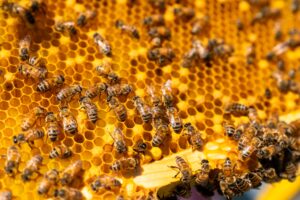Thanks to genetically modified (GM) crops, farmers have been able to upscale production of vital crops to feed our growing world. It is estimated that GM crops have increased the income of farmers by more than US$167 million since 1996.
GM crops are found pretty much everywhere, with more than 185 million hectares cultivated worldwide.
But in some countries, GM food also has a long history of controversy, with health and environmental advocates arguing against their use, despite the science backing up their safety.
As a consequence, in countries like Australia, GM produce still has a long way to go before reaching our tables.
GM crops of Super bananas and red-fleshed apples
Worldwide, around 250 million preschool children suffer from vitamin A deficiency because they don’t get enough of this vitamin in their diet. As a result, around half a million of these children develop blindness, and up to 250,000 will die within the first 12 months of losing sight.
But what if you could load a popular fruit with the needed vitamin? Recently, scientists from Queensland University of Technology tweaked the DNA of the humble banana to create a super banana. Unlike the regular banana, this GM banana is rich in provitamin A (a precursor of vitamin A in our bodies) and iron.
“What we’ve done is take a gene from a banana that originated in Papua New Guinea and is naturally very high in provitamin A but has small bunches and inserted it into a Cavendish banana,” says Professor James Dale, who led the development of this banana, in a recent press release.
Red-fleshed apples, loaded with anthocyanins, nature’s famous antioxidants, are another good example of a super GM fruit. The apples were first developed by Andrew Allan and Richard Espley at Plant & Food Research in New Zealand, and they are quite unique.
“Our engineered apples contain 11,000 micrograms [of anthocyanin] per apple. That’s a 120-fold increase!” says Andrew, comparing the red-fleshed apple to the average apple, which contains about 90 micrograms of anthocyanin. The super apples were developed by tweaking the function of a gene involved in anthocyanin production.

Genetically modified red-fleshed apples contain 120 times more anthocyanin than the average apple.
The Oz GM foodS scene
Sounds good? Unfortunately, you won’t see these super fruits in Australian supermarkets. In fact, the only GM crops currently allowed for cultivation and use in Australia are herbicide-tolerant canola and cotton.
Other GM crops are currently being tested across Australia, from pesticide-resistant bananas to super-sweet fruits.
“Field trials of pineapple, papayas, wheat, barley and sugarcane are under way in Australia. These products have been modified for insect resistance, herbicide tolerance, colour, oil production, sugar composition, flowering and fruit development,” says UWA Winthrop Professor Michael Blakeney.
However, none of these fruits and veggies are planned for public consumption any time soon.

A matter of trust (and money)
So, why don’t we see any red-fleshed apples or super bananas in our supermarkets?
Well, it might be partly our fault—sort of.
“I’m pretty sure the answer is still going to come down to money,” says Heather Bray, a research associate at the University of Adelaide, “as well as perceptions of consumer acceptability [which still comes down to money in the end as it’s a risk for investment],” she adds.
To cultivate or sell any GM organisms in Australia, you need approval from the Gene Technology Regulator. This takes a considerable investment of time and money. So it’s a bit of a risk if no one buys your product at the end.
Bananas are one example. “The Office of the Gene Technology Regulator (OGTR) has approved field trials of bananas genetically modified for disease resistance,” says Heidi Mitchell, Director of the Plant Evaluation Section at OGTR. “But no one has applied for a commercial release of this GM banana,” she adds.
But don’t feel like you are missing out on the GM technology. Most likely, you have been eating GM-containing food already for a long time. Also, upcoming changes to the laws regulating genetic modification of crops are planned for this year. In November, the OGTR announced plans to allow the use of gene editing techniques without the need to apply for a GM licence. The idea is that, as long as the changes do not involve inserting any DNA from another species, all is good.
“If these technologies lead to outcomes no different to the processes people have been using for thousands of years, then there is no need to regulate them, because of their safe history of use,” said Raj Bhula from the OGTR in a recent news article.
If approved, these changes will allow for the quick development of disease-resistant, drought-resistant or high-yielding genetically engineered crops.
There are also several crops currently being tested in Australia. For a full list of what GM plants are approved in Australia, check out the OGTR website. Here you can see a map of where in Australia different GM crops are being tested. If you have something to say about genetically modified foods, you can even send your comments to the OGTR.
But, ultimately, if you want to see super bananas or red-fleshed apples on your table, a change of heart is needed in the Australian marketplace.









